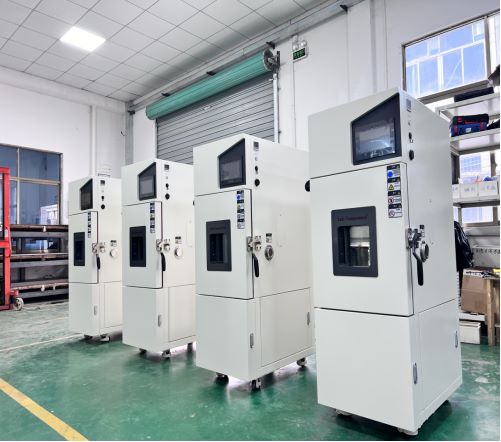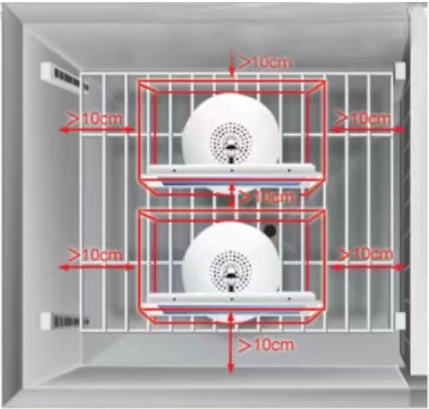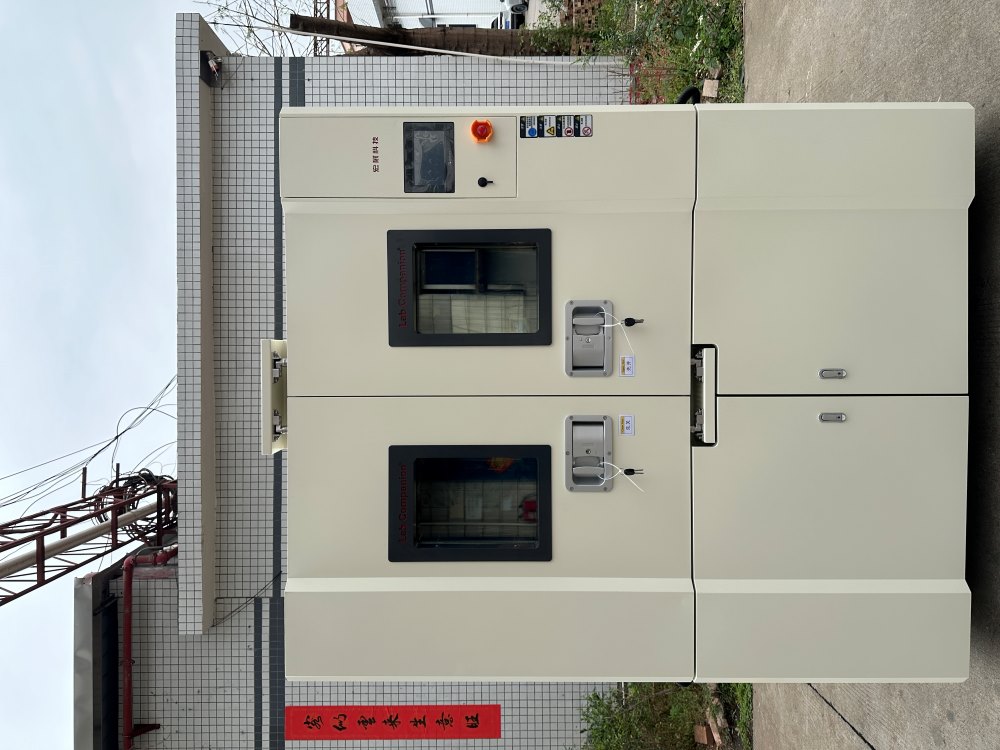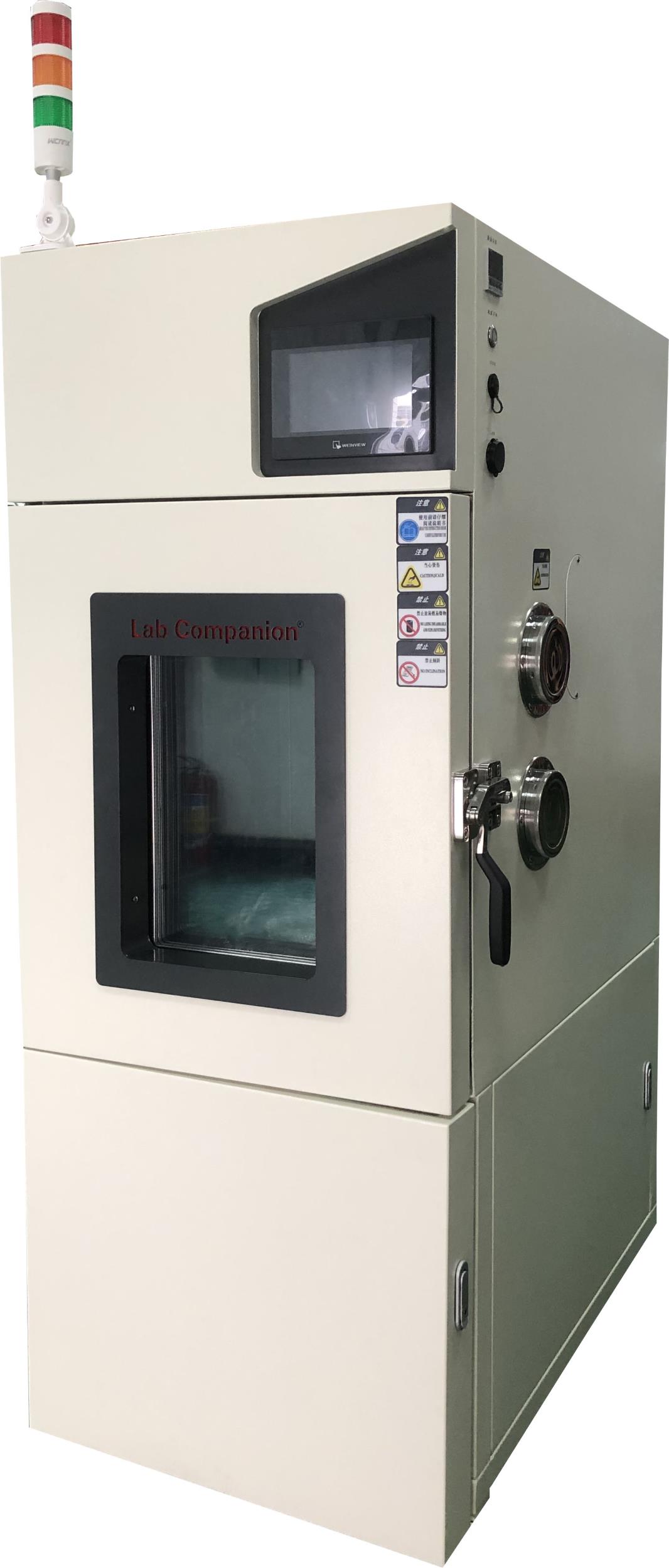IEC 60068-2
Instructions:
IEC(International Electrotechnical Association) is the world's oldest non-governmental international electrical standardization organization, for the people's livelihood of the electronic products to develop relevant test specifications and methods, such as: mainframe board, notebook computers, tablets, smartphones, LCD screens, game consoles... The main spirit of its test is extended from IEC, the main representative of which is IEC60068-2, environmental test conditions its [environmental test] refers to the sample exposed to natural and artificial environments, but the performance of its actual use, transportation and storage conditions are evaluated. The environmental test of the sample can be uniform and linear through the use of standardized standards. Environmental testing can simulate whether the product can adapt to environmental changes (temperature, humidity, vibration, temperature change, temperature shock, salt spray, dust) at different stages (storage, transport, use). And verify that the characteristics and quality of the product itself will not be affected by it, low temperature, high temperature, temperature impact can produce mechanical stress, this stress makes the test sample more sensitive to the subsequent test, impact, vibration can produce mechanical stress, this stress can make the sample immediately damaged, air pressure, alternating humid heat, constant humid heat, corrosion application of these tests and can be continued thermal and mechanical stress test effects.

Important IEC specification sharing:
IEC69968-2-1- Cold
Test purpose: To test the ability of automotive components, equipment or other component products to operate and store at low temperatures.
Test methods are divided into:
1.Aa: Temperature sudden change method for non-thermal specimens
2.Ab: Temperature gradient method for non-thermal specimens
3.Ad: Temperature gradient method of thermogenic specimen
Note:
Aa:
1. Static test (without power supply).
2. First cool down to the specified temperature of the specification before placing the test part.
3. After stability, the temperature difference of each point on the specimen does not exceed ±3℃.
4. After the test is completed, the specimen is placed under standard atmospheric pressure until the fog is completely removed: no voltage is added to the specimen during the transfer process.
5. Measure after returning to the original condition (at least 1hr).
Ab:
1. Static test (without power supply).
2. The specimen is placed in the cabinet at room temperature, and the temperature change of the cabinet temperature does not exceed 1℃ per minute.
3. The specimen shall be kept in the cabinet after the test, and the temperature change of the cabinet temperature shall not exceed 1℃ per minute to return to the standard atmospheric pressure; The specimen should not be charged during temperature change.
4. Measure after returning to the original condition (at least 1hr). (The difference between the temperature and the air temperature is more than 5℃).
Ac:
1. Dynamic test (plus power supply) when the temperature of the specimen is stable after charging, the temperature of the specimen surface is the most hot spot.
2. The specimen is placed in the cabinet at room temperature, and the temperature change of the cabinet temperature does not exceed 1℃ per minute.
3. The specimen should be kept in the cabinet after the test, and the temperature change of the cabinet temperature should not exceed 1℃ per minute, and return to the standard atmospheric pressure; The specimen should not be charged during temperature change.
4. Measure after returning to the original condition (at least 1hr).
Test conditions:
1. Temperature :-65,-55,-40,-25,-10,-5,+5°C
2. Resident time :2/16/72/96 hours.
3. Temperature variation rate: no more than 1℃ per minute.
4. Tolerance error :+3°C.
Test setup:
1. Heat generating specimens should be placed in the center of the test cabinet and the wall of the cabinet > 15cm
Sample to specimen > 15cm test cabinet to test volume ratio > 5:1.
2. For heat-generating specimens, if air convection is used, the flow rate should be kept to a minimum.
3. The specimen should be unpacked, and the fixture should have the characteristics of high heat conduction.
IEC 60068-2-2- Dry heat
Test purpose: To test the ability of components, equipment or other component products to operate and store in high temperature environments.
The test method is:
1. Ba: Temperature sudden change method for non-thermal specimens
2.Bb: Temperature gradient method for non-thermal specimens
3.Bc: Temperature sudden change method for thermogenic specimens
4.Bd: Temperature gradient method for thermogenic specimens
Note:
Ba:
1. Static test (without power supply).
2. First cool down to the specified temperature of the specification before placing the test part.
3. After stability, the temperature difference of each point on the specimen does not exceed +5℃.
4. After the test is completed, place the specimen under standard atmospheric pressure and return to the original condition (at least 1hr).
Bb:
1. Static test (without power supply).
2. The specimen is placed in the cabinet at room temperature, and the temperature change of the cabinet temperature does not exceed 1℃ per minute, and the temperature is reduced to the temperature value specified in the specification.
3. The specimen shall be kept in the cabinet after the test, and the temperature change of the cabinet temperature shall not exceed 1℃ per minute to return to the standard atmospheric pressure; The specimen should not be charged during temperature change.
4. Measure after returning to the original condition (at least 1hr).
Bc:
1. Dynamic test (external power supply) When the temperature of the specimen is stable after charging, the difference between the temperature of the hottest spot on the surface of the specimen and the air temperature is more than 5℃.
2. Heat up to the specified temperature of the specification before placing the test part.
3. After stability, the temperature difference of each point on the specimen does not exceed +5℃.
4. After the test is completed, the specimen will be placed under the standard atmospheric pressure, and the measurement will be carried out after the original condition is returned (at least 1hr).
5. The average temperature of the decimal point on the plane of 0~50mm on the bottom surface of the specimen.
Bd:
1. Dynamic test (external power supply) when the temperature of the specimen is stable after charging, the temperature of the most hot spot on the surface of the specimen is more than 5°C different from the air temperature.
2. The specimen is placed in the cabinet at room temperature, and the temperature change of the cabinet temperature does not exceed 1℃ per minute, and rises to the specified temperature value.
3. Return to standard atmospheric pressure; The specimen should not be charged during temperature change.
4. Measure after returning to the original condition (at least 1hr).
Test conditions:
1. The temperature 1000,800,630,500,400,315,250,200,175,155,125,100,85,70,55,40,30 ℃.
1. Resident time: 2/16/72/96 hours.
2. Temperature variation rate: no more than 1℃ per minute. (Average in 5 minutes)
3. Tolerance error: tolerance of ±2℃ below 200℃. (200~1000℃ tolerance ±2%)
IEC 60068-2-2- Test method Ca: Steady damp heat
1. Test purpose:
The purpose of this test method is to determine the adaptability of components, equipment or other products to operation and storage at constant temperature and high relative humidity.
Step 2: Scope
This test method can be applied to both heat-dissipating and non-heat-dissipating specimens.
3. No limits
4. Test steps:
4.1 Specimens shall be inspected visually, electrically and mechanically in accordance with relevant specifications before testing.
4.2 The test specimen must be placed in the test cabinet in accordance with the relevant specifications. In order to avoid the formation of water droplets on the test specimen after it is placed in the cabinet, it is best to preheat the temperature of the test specimen to the temperature condition in the test cabinet in advance.
4.3 The specimen shall be insulated in accordance with the specified residence.
4.4 If specified in the relevant specifications, functional tests and measurements shall be performed during or after the test, and the functional tests shall be performed in accordance with the cycle required in the specifications, and the test pieces shall not be moved out of the test cabinet.
4.5 After the test, the specimen must be placed under standard atmospheric conditions for at least one hour and at most two hours to return to its original condition. Depending on the characteristics of the specimen or the different laboratory energy, the specimen can be removed or retained in the test cabinet to wait for recovery, if you want to remove the time to be as short as possible, preferably not more than five minutes, if maintained in the cabinet the humidity must be reduced to 73% to 77% R.H. within 30 minutes, while the temperature must also reach the laboratory temperature within 30 minutes +1℃ range.
5. Test conditions
5.1 Test temperature: The temperature in the test cabinet should be controlled within the range of 40+2°C.
5.2 Relative humidity: The humidity in the test cabinet should be controlled at 93(+2/-3)% R.H. Within the range.
5.3 Resident time: The resident time can be 4 days, 10 days, 21 days or 56 days.
5.4 Test tolerance: temperature tolerance is +2℃, error of packet content measurement, slow change of temperature and temperature difference in the temperature cabinet. However, in order to facilitate the maintenance of humidity within a certain range, the temperature of any two points in the test cabinet should be maintained within the minimum range as far as possible at any time. If the temperature difference exceeds 1 ° C, the humidity changes beyond the permissible range. Therefore, even short-term temperature changes may need to be controlled within 1 ° C.
6. Test setup
6.1 Temperature and humidity sensing devices must be installed in the test cabinet to monitor the temperature and humidity in the cabinet.
6.2 There shall be no condensation water droplets on the test specimen at the top or wall of the test cabinet.
6.3 The condensed water in the test cabinet must be discharged continuously and shall not be used again unless it is purified (re-purifed).
6.4 When the humidity in the test cabinet is achieved by spraying water into the test cabinet, the moisture resistance coefficient shall not be less than 500Ω.
7. Other
7.1 The temperature and humidity conditions in the test cabinet must be uniform and similar to those in the vicinity of the temperature and humidity sensor.
7.2 The temperature and humidity conditions in the test cabinet shall not be changed during the power-on or functional test of the specimen.
7.3 Precautions to be taken when removing moisture from the specimen surface shall be detailed in the relevant specifications.
IEC 68-2-14 Test method N: Temperature variation
1. Test purpose
The purpose of this test method is to determine the effect of the specimen on the environment of temperature change or continuous temperature change.
Step 2: Scope
This test method can be divided into:
Test method Na: Rapid temperature change within a specified time
Test method Nb: Temperature change at specified temperature variability
Test method Nc: Rapid temperature change by double liquid immersion method.
The first two items apply to components, equipment or other products, and the third item applies to glass-metal seals and similar products.
Step 3 Limit
This test method does not validate high or low temperature environmental effects, and if such conditions are to be validated, "IEC68-2-1 test Method A:" cold "or "IEC 60068-2-2 Test Method B: dry heat" should be used.
4. Test procedure
4.1 Test method Na:
Rapid temperature change in a specific time
4.1.1 Specimens shall be inspected visually, electrically and mechanically in accordance with relevant specifications before testing.
4.1.2 The specimen type shall be unpacked, unpowered and ready for use or other conditions specified in relevant specifications. The initial condition of the specimen was room temperature in the laboratory.
4.1.3 Adjust the temperature of the two temperature cabinets respectively to the specified high and low temperature conditions.
4.1.4 Place the specimen in the low-temperature cabinet and keep it warm according to the specified residence time.
4.1.5 Move the specimen into the high-temperature cabinet and keep it warm according to the specified residence time.
4.1.6 The transfer time of high and low temperature shall be subject to the test conditions.
4.1.7 Repeat the procedure of Steps 4.1.4 and 4.1.5 four times
4.1.8 After the test, the specimen should be placed under standard atmospheric conditions and kept for a certain time to make the specimen reach temperature stability. The response time shall refer to the relevant regulations.
4.1.9 After the test, the specimens shall be inspected visually, electrically and mechanically in accordance with relevant specifications.
4.2 Test method Nb:
Temperature change at a specific temperature variability
4.2.1 The specimens shall be inspected visually, electrically and mechanically in accordance with relevant specifications before testing.
4.2.2 Place the test piece in the temperature cabinet. The shape of the test piece should be unpacked, unpowered and ready for use or other conditions specified in relevant specifications. The initial condition of the specimen was room temperature in the laboratory.
The specimen can be made operational if required by the relevant specification.
4.2.3 The temperature of the cabinet shall be lowered to the prescribed low temperature condition, and the insulation shall be carried out according to the prescribed residence time
4.2.4 The temperature of the cabinet shall be raised to the specified high temperature condition, and heat preservation shall be carried out according to the specified residence time
4.2.5 The temperature variability of high and low temperature shall be subject to the test conditions.
4.2.6 Repeat the procedure in Steps 4.2.3 and 4.2.4:
Electrical and mechanical tests shall be performed during the test.
Record the time used for electrical and mechanical testing.
After the test, the specimen should be placed under standard atmospheric conditions and kept for a certain time to make the specimen reach the temperature stability recovery time referred to the relevant specifications.
After the test, the specimens shall be inspected visually, electrically and mechanically in accordance with the relevant specifications
5. Test conditions
Test conditions can be selected by the following appropriate temperature conditions and test time or in accordance with the relevant specifications,
5.1 Test method Na:
Rapid temperature change in a specific time
High temperature: 1000800630500400315250200175155125100,85,70,55,4030 ° C
Low temperature :-65,-55,-40,-25.-10.-5 °C
Humidity: Vapor content per cubic meter of air should be less than 20 grams (equivalent to 50% relative humidity at 35 ° C).
Residence time: The temperature adjustment time of the temperature cabinet can be 3 hours, 2 hours, 1 hour, 30 minutes or 10 minutes, if there is no provision, it is set to 3 hours. After the test piece is placed in the temperature cabinet, the temperature adjustment time cannot exceed one-tenth of the residence time. Transfer time: manual 2~3 minutes, automatic less than 30 seconds, small specimen less than 10 seconds.
Number of cycles :5 cycles.
Test tolerance: The tolerance of temperature below 200℃ is +2℃
The tolerance of the temperature between 250 and 1000C is +2% of the test temperature. If the size of the temperature cabinet cannot meet the above tolerance requirements, the tolerance can be relaxed: the tolerance of the temperature below 100 ° C is ±3 ° C, and the tolerance of the temperature between 100 and 200 ° C is ±5 ° C (the tolerance relaxation should be indicated in the report).
5.2 Test method Nb:
Temperature change at a specific temperature variability
High temperature: 1000800630500400315250200175155125100,85,70 55403 0 'C
Low temperature :-65,-55,-40,-25,-10,-5,5℃
Humidity: Vapor per cubic meter of air should be less than 20 grams (equivalent to 50% relative humidity at 35 ° C) Residence time: including rising and cooling time can be 3 hours, 2 hours, 1 hour, 30 minutes or 10 minutes, if there is no provision, set to 3 hours.
Temperature variability: The average temperature fluctuation of the temperature cabinet within 5 minutes is 1+0.2 ° C /min, 3+0.6 ° C /min, or 5+1 ° C /min.
Number of cycles :2 cycles.
Test tolerance: The tolerance of temperature below 200℃ is +2℃.
The tolerance of the temperature between 250 and 1000℃C is +2% of the test temperature. If the size of the temperature cabinet cannot meet the above tolerance requirements, the tolerance can be relaxed. The tolerance of the temperature below 100 ° C is +3 ° C. The temperature between 100 ° C and 200 ° C is +5 ° C. (The tolerance relaxation should be indicated in the report).
6. Test setup
6.1 Test method Na:
Rapid temperature change in a specific time
The difference between the inner wall temperature of the high and low temperature cabinets and the temperature test specifications shall not exceed 3% and 8%(shown in °K) respectively to avoid thermal radiation problems.
The thermogenic specimen should be placed in the center of the test cabinet as far as possible, and the distance between the specimen and the cabinet wall, the specimen and the specimen should be greater than 10 cm, and the ratio of the volume of the temperature cabinet and the specimen should be greater than 5:1.

6.2 Test method Nb:
Temperature change at a specific temperature variability
Specimens shall be inspected visually, electrically and mechanically in accordance with relevant specifications before testing.
The specimen shall be in unpacked, unpowered and ready for use condition or other conditions specified in relevant specifications. The initial condition of the specimen was room temperature in the laboratory.
Adjust the temperature of the two temperature cabinets respectively to the specified high and low temperature conditions
The specimen is placed in a low-temperature cabinet and kept warm according to the specified residence time
The specimen is placed in a high temperature cabinet and insulated according to the specified residence time.
The transfer time of high and low temperature shall be performed according to the test conditions.
Repeat the procedure of steps d and e four times.
After the test, the specimen should be placed under standard atmospheric conditions and kept for a certain time to make the specimen reach the temperature stability recovery time referred to the relevant specifications.
After the test, the specimens shall be inspected visually, electrically and mechanically in accordance with the relevant specifications
6.3 Test method NC:
Rapid temperature change of double liquid soaking method
The liquid used in the test shall be compatible with the specimen and shall not harm the specimen.
7. Others
7.1 Test method Na:
Rapid temperature change in a specific time
When the specimen is placed in the temperature cabinet, the temperature and air flow rate in the cabinet must reach the specified temperature specification and tolerance within one-tenth of the holding time.
The air in the cabinet must be maintained in a circle, and the air flow rate near the specimen must not be less than 2 meters per second (2m/s).
If the specimen is transferred from the high or low temperature cabinet, the holding time cannot be completed for some reason, it will stay in the previous holding state (preferably at low temperature).
7.2 Test method Nb:
The air in the cabinet must be maintained in a circle at a specific temperature variability, and the air flow rate near the specimen must not be less than 2 meters per second (2m/s).
7.3 Test method NC:
Rapid temperature change of double liquid soaking method
When the specimen is immersed in the liquid, it can be quickly transferred between the two containers, and the liquid cannot be stirred.

